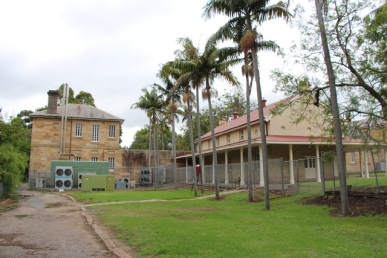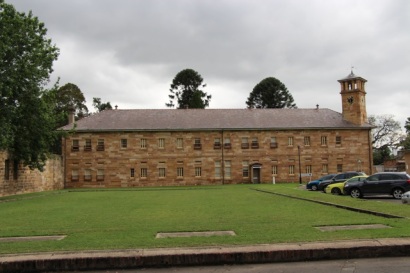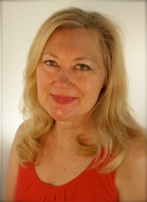 After decades of lobbying for the preservation of heritage sites in North Parramatta, by organisations including the National Trust, the Parramatta Female Factory, and Parramatta Female Factory Precinct, the announcement by the state government of preparation of a Framework Masterplan in 2013 was given a cautious welcome. To stimulate thinking before the first charrette, Parramatta state MP, Dr Geoff Lee, nominated the Boston Freedom Trail as his favourite model of a contemporary urban location profoundly enriched by highlighting Boston’s heritage and history. Increasingly, fears are being expressed that this is not the outcome of the Parramatta North Urban Renewal Transformation Project. Above, right, is the 1820s third class women’s quarters, currently surrounded by a construction fence.
After decades of lobbying for the preservation of heritage sites in North Parramatta, by organisations including the National Trust, the Parramatta Female Factory, and Parramatta Female Factory Precinct, the announcement by the state government of preparation of a Framework Masterplan in 2013 was given a cautious welcome. To stimulate thinking before the first charrette, Parramatta state MP, Dr Geoff Lee, nominated the Boston Freedom Trail as his favourite model of a contemporary urban location profoundly enriched by highlighting Boston’s heritage and history. Increasingly, fears are being expressed that this is not the outcome of the Parramatta North Urban Renewal Transformation Project. Above, right, is the 1820s third class women’s quarters, currently surrounded by a construction fence.
Inara Molinari’s submission to the Department of Planning and Environment crystalised my own concerns after attending the first two community workshops and those of many other community participants who felt they were rushed through the processes. Under discussion is a site that has been a gathering place for the Darug people for thousands of years, Inara writes, and one that stands witness to the historical development of our modern nation from its colonial beginnings in 1788. “Few other sites in Australia have seen nearly 200 years of ‘continuous institutional use since the construction of the Female Factory in 1818’ . . . a use that reflects our changing attitudes to the welfare system, incarceration, mental health, and our social and moral values, particularly in relation to women and children.”
 The 1884 ward building constructed using sandstone from the original female factory building and the clock tower and bell. To the left is the sandstone wall of the third class yard, built in about 1838. Photos above and alongside by Inara Molinari.
The 1884 ward building constructed using sandstone from the original female factory building and the clock tower and bell. To the left is the sandstone wall of the third class yard, built in about 1838. Photos above and alongside by Inara Molinari.
Where is the “principled, world’s best practice approach” needed for a nationally, if not internationally significant site?, she asks. She compares the treatment of the North Parramatta site with the Bays Precinct Renewal Project also managed by UrbanGrowth NSW. It was subject to an international summit in November 2014 with expertise drawn from a wide range of authorities. Inara has other questions:
Why can the preservation of heritage buildings on the site only be funded by the sale of surrounding land? Why not the rezoning and redevelopment elsewhere of land in the Parramatta LGA and Metropolitan West Central and North West Subregion?
What options for sustainable preservation have been explored other than a fast-tracked, pre-determined scheme of residential and commercial development?
Why were stakeholder charrettes steered towards acceptance of key industry development concerns, while not addressing wider stakeholder concerns?
Why was the range of stakeholders engaged in consultation so small in number and lacking the diversity, breadth and independence appropriate to the national significance of the study area?
Why are proposal documents detailed in relation to form and height of new buildings, but offer no detail about the ownership, management and adaptive re-use envisaged for the heritage buildings?
Finally, she asks, why doesn’t UrbanGrowth NSW appear to be following its “City Transformation Life Cycle”, described as “a new global methodology for the urban transformation of cities”?
Inara M olinari, pictured, has an unusual combination of qualifications and experience. She has an arts/law degree, practised in law for three years, has a diploma in operatic studies, a 20 year record as a professional singer (including Opera Australia chorus and more locally, Packemin Productions) , conductor, director and producer. In 2008, she became a qualified nurse with specialist study in diabetes education and management. She grew up in the regional city of Geelong, in Victoria, has lived and worked internationally and for the last five years has lived with her family in Granville. Through her studies, Inara has become passionate about preventative health and the issues associated with urban development, our environment and the social constraints that can negatively impact on an individual’s sense of well-being. With that perspective, she committed four days in early January to an intense critical review of the North Parramatta Urban Renewal proposals developed by UrbanGrowth NSW and made a submission to the Department of Planning and Environment.
olinari, pictured, has an unusual combination of qualifications and experience. She has an arts/law degree, practised in law for three years, has a diploma in operatic studies, a 20 year record as a professional singer (including Opera Australia chorus and more locally, Packemin Productions) , conductor, director and producer. In 2008, she became a qualified nurse with specialist study in diabetes education and management. She grew up in the regional city of Geelong, in Victoria, has lived and worked internationally and for the last five years has lived with her family in Granville. Through her studies, Inara has become passionate about preventative health and the issues associated with urban development, our environment and the social constraints that can negatively impact on an individual’s sense of well-being. With that perspective, she committed four days in early January to an intense critical review of the North Parramatta Urban Renewal proposals developed by UrbanGrowth NSW and made a submission to the Department of Planning and Environment.
“Realising the ambition that Parramatta be ‘A Strong Global City’ and ‘A Great Place to Live’ is long overdue,” Inara writes. “The PNUR precinct provides an opportunity to realise this ambition through creating an integrated network of public parkland that stretches from Lake Parramatta’s natural bushland, through the Cumberland and Sport and Leisure Precincts with connectivity to Parramatta Park and Old Government House, through to Riverside Theatres and Eat Street. The precinct could readily incorporate the reuse of historical buildings for medical research, education and cultural facilities.” She outlines a proposal for a Centre of Excellence for Preventative Health and a museum and cultural precinct that links with the National Museum of Australia. Her proposals are clearly sympathetic with those of the Parramatta Female Factory Precinct, the National Trust and the long-advocated Parramatta Arts Precinct.
Included in the National Trust’s position is the statement: “The Trust understands that there is considerable high-rise commercial/residential tower development proposed within the Parramatta CBD, which reinforces the importance of conserving the 166 year old Cumberland Hospital/Wistaria Gardens landscape intact for future generations to experience and enjoy.”
Proposals for high rise urban development that overwhelms the precious heritage assets of the area, corrupts the views and experience of our national identity and removes valuable land from public ownership is not the solution for North Parramatta. “The planning for North Parramatta must be conceived and developed from a wider perspective to capture the real value for the whole community.” You can still sign Bonney Djuric’s petition for an extension of the submission deadline to at least February 27.

Maintain the rage !!!!!!
LikeLike